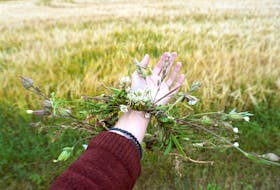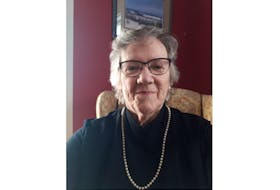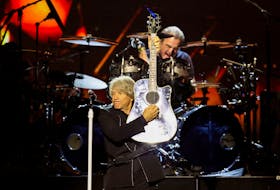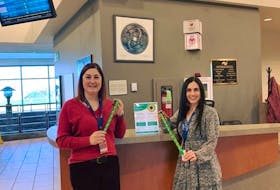MAITLAND BRIDGE, N.S. — Todd Labrador has had engineers marvel at the sophistication of the birch bark canoe.
“They look at this and they’re still amazed,” he said. “You have an engineer, who has a lot of knowledge through universities and studies, but they look at this and see how it all comes together and they’re quite amazed at the skill that was here thousands of years ago.”
And it’s not just the skill, it’s the design that goes back millennia.
“I really don’t think you can improve on this,” Labrador said. “Maybe you could put seats in it – because they didn’t have seats.”
It’s Oct. 12 and he’s on the bank of the Mersey River where it flows out into Kejimkujik Lake. He explains the two birch bark canoes at the edge of the water, built at Keji in the summer, soon to be launched for the first time. A large crowd is gathering, and modern-day canoes and kayaks of all description are scattered along the shore. They’ll be part of a flotilla around to Kedge Beach.
“This one’s a 21-foot ocean canoe – ocean and rough water,” Labrador said. “You can see it’s raised in the middle. That’s the one with the sail.” The second one is 19 feet long and is also meant for the ocean. It’s not rigged with a sail, but it could be.
In a few minutes Labrador will light some sweet grass and using an eagle’s feather waft the smoke over the canoes to purify them prior to their first launch. A Mi’kmaq youngster will drum and sing. And there will be a prayer.
PETROGLYPHS
“You see that image on the side?” Labrador asks, pointing at the big canoe and an image etched into the bark depicting people in a canoe throwing what look like spears at a small whale. “That’s actually a petroglyph from down here in Fairy Bay – ocean-going canoe with a whale. They hunted whales by canoe. We know our people were experts on the ocean. They travelled to Newfoundland. They travelled to Prince Edward Island. They travelled to New Brunswick. My great-grandfather travelled across the Bay of Fundy in a birch bark canoe. So we do know our people were experts on the water.”
There are dozens of documented Mi’kmaq archeological sites in Keji dating back 6,500 years.
“And we’re still finding more where our people worked or hunted or lived,” Labrador said. “They would have had lots of these (canoes). The waterway for thousands of years was the highway. The canoe was the vehicle.”
Labrador also etched into the canoe the seven-pointed symbol that represented the seven districts of the Mi’kmaq nation prior to European arrival. “Often times chiefs will use that symbol somewhere on their clothing to symbolize that they are chief,” he said.
The white canvas sail is etched with part of ‘The Gathering,’ another petroglyph found at Fairy Bay.

BLOOD MEMORY
The wood is cedar from New Brunswick, although he could use local spruce. “Cedar works easier. A lot of the wood is local -- spruce, ash, birch, even some beech,” he said. “The paddles are beech.”
And the canoes are held together with thousands of feet of spruce roots.
Labrador talks about blood memory – innate knowledge. Ability you’re born with that comes back when you start to use it. And he knows now it was always in his blood. Genealogical digging seems to prove that. He has a lot of canoe builders in his blood, in his family, it turns out -- Jeremys, Pictous, the Labradors.
“I always say it’s in my blood and something that I always feel,” he said. “It’s almost like something’s calling me to do this. And it’s always been like that. I’ve always been called to the woods. Called to the traditions and it’s always been in me. For me it’s just a natural feeling.”

MATERIALS
And while blood memory is significant, Labrador said the materials often tell him how to work.
“The materials teach. I learned a lot from the roots. I learned a lot from the bark and the wood,” he said. “Even though the elders had passed on, the materials will teach you. If you are a good student, you can learn amazing things from whatever Mother Earth gives us.”
For instance, the actual act of using the roots, teachers you how to use them.
“And if you do something wrong it will teach you,” he said. “If you keep a close watch you can learn a lot. A lot of the elders never talked a lot. But people learned from the elders by watching them.”
Rose Meuse understands. She worked with Labrador to build those two birch bark canoes and spoke at the canoe launch.
“It was such a privilege to build these, but this is really only icing on the cake for me,” she said. “The stories that we shared and the things that I learned from the material itself and bringing all that tradition back. That was really the most important for me. We got to do a lot of that. I’ll never forget all the experience that came with this.”

WORKS OF ART
Park superintendent Jonathan Sheppard said the two birch bark canoes represent so much.
“At their face value they are works of art,” he said.
But they mean more than that.
“These canoes represent an incredible connection to the land,” he said. “As you well know, Todd and family have incredible connections here to Kejimkujik and the spirit of canoe building runs so deep in the rivers and the lands around here. And it’s really humbling for all of us to be able to see the power of that building and that connection to the land and the way that has come together.”
He described the canoe as a really powerful symbol and said through Labrador and Meuse he has learned how much the birchbark canoe means to Mi’kmaq culture.
“I think even today what we see in Kejimkujik is that the canoe is also still a real symbol of how people connect with, experience, and care about this landscape,” he said. “So that continuity of connection with the canoe is so very incredible.”
The two birch bark canoes are launched and the flotilla glides silently across glassy water and into the mist – headed for Kedge Beach, bannock, and blueberry tea.







